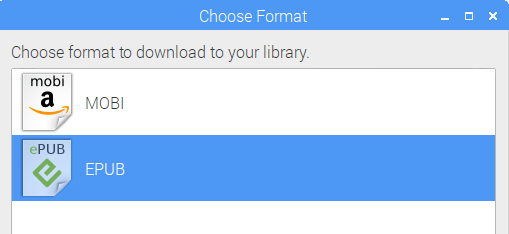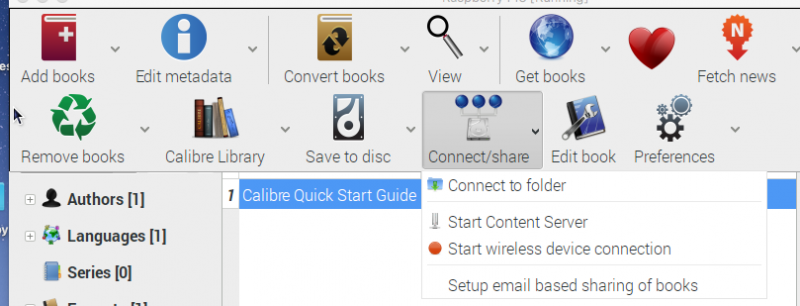Building an e-book service using Raspberry Pi
| Introduction | Caliber 3.0 was recently released, which allows users to read e-books in the browser! Note that Raspbian's repository has not updated it (as of writing). E-books are a great way for teachers, librarians, and others to share books, class materials, or other files with students, as long as you have reliable bandwidth access. But even if you have a slow or no connection, there's a simple solution: Create an e-book server using the open-source Caliber e-book management software that runs on a Raspberry Pi 3. This is what I did and you can too. |
First I downloaded the latest Raspbian Pixel image and installed it on a new 8GB microSD card. I then plugged in the microSD, connected a keyboard, mouse and an HDMI cable to an old LCD TV, and booted up the Pi. After adjusting the Pixel environment resolution on my monitor and connecting to a local network, I was ready to get started. I opened a terminal and typed
sudo apt-get update
to get the latest updates for your operating system.

Updating Raspbian Pixel
Next, I type
in the terminalsudo apt-get install calibre
To install Caliber.

Installing Caliber
I started Caliber from the command line (note it can also be started from the GUI). Caliber's interface is very intuitive. When you start it for the first time, you will see the Welcome to Caliber wizard. I changed the default "Caliber Library" to "CaliberLibrary" (one word) because this is easier when starting the content server.
After selecting the location for my Caliber content, I'm ready to start downloading the book.

Caliber's interface
I selected the Get Books option from the menu, where it was easy to enter my search terms and select the ebook providers I was interested in. I was looking for DRM-free material, so I chose Project Gutenberg as my source. (Caliber's disclaimer states that ebook transactions are between you and the individual content provider.) I entered "Mark Twain" into the author field and got 10 results.

Searching for e-books
I chose the book Adventures of Huckleberry Finn. On the next page, I can choose between the two ebook formats MOBI and EPUB. I chose EPUB and the book downloaded very quickly.

Choosing the e-book format
You can also add books to the library from other content providers instead of adding them to Caliber's list. For example, teachers can share open educational resources in e-book format with students through this content server. To load content, use the "Add Books" option on the far left side of the interface.
Depending on the size of your library, you may need to increase the size of your microSD card.

start_the_server.png
Once you add content to the eBook server, you can share the content with others on your network. By typing
in the terminalifconfig
Get your Raspberry Pi IP address. I'm using a wireless network, so I used the results from wlan0 in the example below. Click on the far right side of the interface and expand the menu. Then click “Connect and Share” and start the server.

Identifying the IP address with ipconfig
My next step is to access the e-book I added via my computer client connected to the Raspberry Pi. I opened a browser on the client and entered the address of the Raspberry followed by the port :8080. In my case it is http://192.168.1.10:8080 (Adapt it according to the address of your Pi).
You will see the home page in your browser:

Caliber's client homepage
I have tested and can easily connect to the server using iPhone, Linux, and MacOS computers.
You can explore the options from this home page, or click All Books to display all content on the server.

Browsing e-books
From here, you can download the book to your device and read it offline.
Have you not set up an e-book server yet? Or are you considering setting up one yourself? Share your suggestions or questions in the comments.
The above is the detailed content of Building an e-book service using Raspberry Pi. For more information, please follow other related articles on the PHP Chinese website!

Hot AI Tools

Undresser.AI Undress
AI-powered app for creating realistic nude photos

AI Clothes Remover
Online AI tool for removing clothes from photos.

Undress AI Tool
Undress images for free

Clothoff.io
AI clothes remover

Video Face Swap
Swap faces in any video effortlessly with our completely free AI face swap tool!

Hot Article

Hot Tools

Notepad++7.3.1
Easy-to-use and free code editor

SublimeText3 Chinese version
Chinese version, very easy to use

Zend Studio 13.0.1
Powerful PHP integrated development environment

Dreamweaver CS6
Visual web development tools

SublimeText3 Mac version
God-level code editing software (SublimeText3)

Hot Topics
 1386
1386
 52
52
 How to use docker desktop
Apr 15, 2025 am 11:45 AM
How to use docker desktop
Apr 15, 2025 am 11:45 AM
How to use Docker Desktop? Docker Desktop is a tool for running Docker containers on local machines. The steps to use include: 1. Install Docker Desktop; 2. Start Docker Desktop; 3. Create Docker image (using Dockerfile); 4. Build Docker image (using docker build); 5. Run Docker container (using docker run).
 Difference between centos and ubuntu
Apr 14, 2025 pm 09:09 PM
Difference between centos and ubuntu
Apr 14, 2025 pm 09:09 PM
The key differences between CentOS and Ubuntu are: origin (CentOS originates from Red Hat, for enterprises; Ubuntu originates from Debian, for individuals), package management (CentOS uses yum, focusing on stability; Ubuntu uses apt, for high update frequency), support cycle (CentOS provides 10 years of support, Ubuntu provides 5 years of LTS support), community support (CentOS focuses on stability, Ubuntu provides a wide range of tutorials and documents), uses (CentOS is biased towards servers, Ubuntu is suitable for servers and desktops), other differences include installation simplicity (CentOS is thin)
 What to do if the docker image fails
Apr 15, 2025 am 11:21 AM
What to do if the docker image fails
Apr 15, 2025 am 11:21 AM
Troubleshooting steps for failed Docker image build: Check Dockerfile syntax and dependency version. Check if the build context contains the required source code and dependencies. View the build log for error details. Use the --target option to build a hierarchical phase to identify failure points. Make sure to use the latest version of Docker engine. Build the image with --t [image-name]:debug mode to debug the problem. Check disk space and make sure it is sufficient. Disable SELinux to prevent interference with the build process. Ask community platforms for help, provide Dockerfiles and build log descriptions for more specific suggestions.
 How to view the docker process
Apr 15, 2025 am 11:48 AM
How to view the docker process
Apr 15, 2025 am 11:48 AM
Docker process viewing method: 1. Docker CLI command: docker ps; 2. Systemd CLI command: systemctl status docker; 3. Docker Compose CLI command: docker-compose ps; 4. Process Explorer (Windows); 5. /proc directory (Linux).
 What computer configuration is required for vscode
Apr 15, 2025 pm 09:48 PM
What computer configuration is required for vscode
Apr 15, 2025 pm 09:48 PM
VS Code system requirements: Operating system: Windows 10 and above, macOS 10.12 and above, Linux distribution processor: minimum 1.6 GHz, recommended 2.0 GHz and above memory: minimum 512 MB, recommended 4 GB and above storage space: minimum 250 MB, recommended 1 GB and above other requirements: stable network connection, Xorg/Wayland (Linux)
 Detailed explanation of docker principle
Apr 14, 2025 pm 11:57 PM
Detailed explanation of docker principle
Apr 14, 2025 pm 11:57 PM
Docker uses Linux kernel features to provide an efficient and isolated application running environment. Its working principle is as follows: 1. The mirror is used as a read-only template, which contains everything you need to run the application; 2. The Union File System (UnionFS) stacks multiple file systems, only storing the differences, saving space and speeding up; 3. The daemon manages the mirrors and containers, and the client uses them for interaction; 4. Namespaces and cgroups implement container isolation and resource limitations; 5. Multiple network modes support container interconnection. Only by understanding these core concepts can you better utilize Docker.
 What is vscode What is vscode for?
Apr 15, 2025 pm 06:45 PM
What is vscode What is vscode for?
Apr 15, 2025 pm 06:45 PM
VS Code is the full name Visual Studio Code, which is a free and open source cross-platform code editor and development environment developed by Microsoft. It supports a wide range of programming languages and provides syntax highlighting, code automatic completion, code snippets and smart prompts to improve development efficiency. Through a rich extension ecosystem, users can add extensions to specific needs and languages, such as debuggers, code formatting tools, and Git integrations. VS Code also includes an intuitive debugger that helps quickly find and resolve bugs in your code.
 How to switch Chinese mode with vscode
Apr 15, 2025 pm 11:39 PM
How to switch Chinese mode with vscode
Apr 15, 2025 pm 11:39 PM
VS Code To switch Chinese mode: Open the settings interface (Windows/Linux: Ctrl, macOS: Cmd,) Search for "Editor: Language" settings Select "Chinese" in the drop-down menu Save settings and restart VS Code




